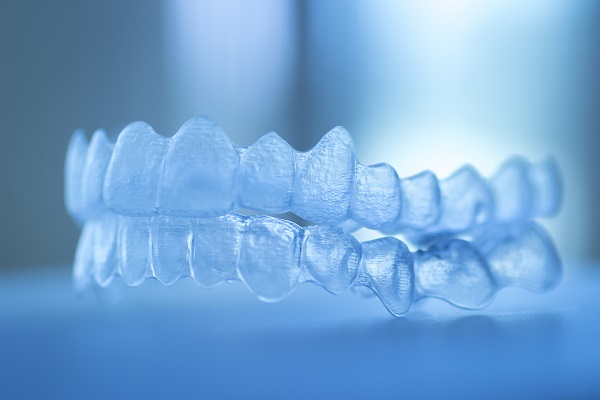Can People Have Their Teeth Whitened During an Invisalign Treatment?

If you have Invisalign aligners to straighten your teeth, you may be noticing results already. With your slowly improving smile, you may be wondering if you can whiten your teeth during your treatment, especially because the Invisalign trays are removable. However, there are a few factors that will determine if you should choose whitening during Invisalign treatment. Read on to learn more.
How teeth whitening works
A dentist will work with a patient to determine the right shade for the teeth. Hair and skin color will be taken into account to achieve a more natural color while still brightening the smile. Then the dentist will protect the patient’s gums with a special gel.
Next, the dentist will apply the whitening solution to the teeth. This generally contains hydrogen peroxide. Sometimes, a special light is used to cure the whitening solution to allow it to set better. The appointment will generally take about half an hour to an hour and a half, and patients will need a few office visits.
Choosing Invisalign
Invisalign works well for people with a variety of orthodontic problems. These problems include:
- Gaps
- Crowded teeth
- Crossbite
- Open bite
- Underbite
- Overbite
This means that there can be a big difference between teeth at the beginning of treatment and the end of treatment. Patients with these problems should generally wait until the end of treatment before choosing to undergo whitening treatment.
Whitening teeth during Invisalign
There are several factors that will determine whether or not a patient should have the teeth whitened during the Invisalign treatment. Sometimes, patients have orthodontic attachments cemented onto the teeth to help the teeth move faster and speed up the treatment. However, if these attachments cannot be removed, it is generally a good idea to wait until after the attachments are removed before trying a whitening treatment.
The whitening solution will whiten the parts of the teeth around the attachment, but the area underneath the attachment will not get whitened. This can make the attachment more noticeable during treatment and leave a spot on the tooth after treatment.
Straighter teeth also generally whiten better than crooked teeth. If a patient gets whitening too early during the treatment while teeth are still crooked, the whitening solution may not evenly coat all surfaces of the teeth that will be exposed after treatment. It is a good idea to wait until closer to the end of the treatment when the teeth are near the final positions.
Visit a dentist today
If you are hoping to end up with straight, white teeth, your dentist can help you achieve that. Your dentist will be able to help you determine when the right time in your Invisalign treatment is for whitening. However, it will be later on in the treatment when teeth are closer to the final positions or after any attachments have been removed. If you have more questions about teeth whitening during Invisalign treatment, visit a dentist today.
Request an appointment here: https://www.gablesexceptionaldentistry.com or call Gables Exceptional Dentistry at (305) 203-4132 for an appointment in our Coral Gables office.
Check out what others are saying about our services on Yelp: Read our Yelp reviews.
Related Posts
Are you considering Invisalign®? Read on to learn more about this teeth-straightening option. The path to a beautiful smile, complete with straight teeth, can be life-changing. Using braces to straighten teeth has been the standard practice for decades. However, new orthodontic treatments have emerged as a result of technological advances. One such innovation is Invisalign,…
Eating with Invisalign ® aligners will be slightly different from your usual routine, but it is entirely manageable with minor adjustments. We often receive questions about eating with Invisalign, so we have answered the most common ones in this review to help you navigate this aspect of your orthodontic treatment. Understanding what patients can and…
Are you looking for CPAP alternatives to treat your sleep apnea? Obstructive sleep apnea is a common condition that impacts millions of individuals all across the globe. Due to this condition, the patient’s airway closes while they are asleep. This can lead to symptoms like difficulty staying asleep throughout the night, snoring, morning headaches, and…
If you want to align your teeth discreetly, you have probably noticed the many options at your disposal, two being Invisalign® and lingual braces. While both options share some similarities, they also have significant differences for you to consider.One of the most significant differences between the two appliances is appearance. Invisaline is virtually invisible, using…
